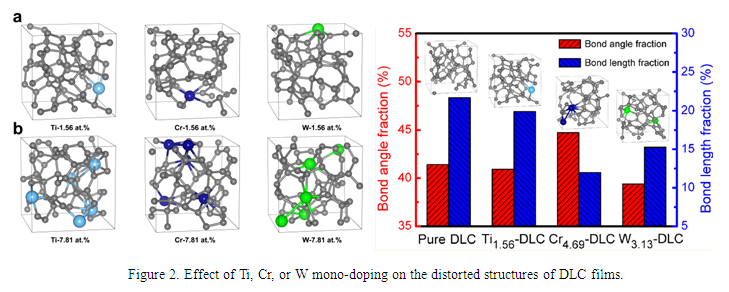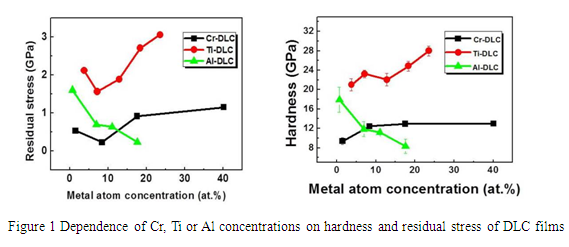Recently, Prof. Aiying Wang and Dr. Xiaowei Li performed ab initio calculations based on density functional theory (DFT) to investigate the structural properties of various Me-DLC films. Ti, Cr, W, Cu and Al were selected as the representative doped metals in terms of strong carbide forming metal and weak carbide ones. It was found that doping Ti, W or Cu into carbon matrix could significantly relax both the distorted bond angles and bond lengths, whereas the Cr or Al doping only relaxed the distorted bond lengths. In spite of the various synergistic effect of distortion, therefore, the reduced fraction of the distorted bond structure and the formation of weak Me-C bond characteristics benefited the residual stress reduction, which consisted with the experimental results and provided the theoretical understanding from atomic scale study (Figure 2). The related results have been published on Journal of Physical Chemistry C (2015) and AIP Advances (2015).

Moreover, utilizing the computation advantages and selecting the Ti, Cr, Cu and Al as the representative elements, they investigated the synergistic effect of binary metal co-doping effect on the structure and property of films. They found that Ti/Al, Cr/Al and W/Al co-doping could further reduce the residual stress with the optimized concentration of doped Ti, Cr, or W to Al. Most importantly, the designed Cu/Cr co-doped material system showing the giant reduction of the residual stress was firstly reported in the literatures to date (Figure 3). Atomic bond structure analysis revealed that the addition of Cu and Cr impurities in amorphous carbon matrix resulted in the critical and significant relaxation of distorted C-C bond lengths. On the other hand, electronic structure calculation indicated a weak bonding interaction formed between Cr and C atoms, while the antibonding interaction was observed for the Cu-C bonds, which played a pivot site for the release of strain energy. As a result, those synergistic interactions of Cu/Cr co-doping combined with the structural evolution accounted for the drastic stress reduction. Noted that if one keeps in mind the designing of selected co-doped metal characteristics, our results present not only a new straight forward strategy to tailor DLC films with low residual stress and other novel physichemical properties, but also foster the theoretical and experimental works of the metal-carbon materials for other functional energy and environmental applications. These results have been published on Applied Materials & Interfaces (2015) and Materials & Design (2016). A Chinese patent has been filed (CN201410528262.5).

Prof. Aiying Wang: aywang@nimte.ac.cn Dr. Xiaowei Li: lixw@nimte.ac.cn
Research Group Url:
All Images by ![]()


